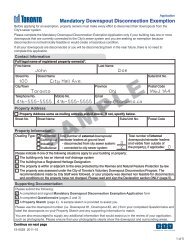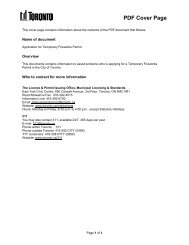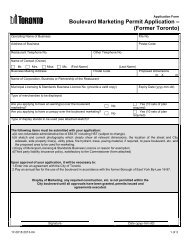St. Lawrence Neighbourhood - City of Toronto
St. Lawrence Neighbourhood - City of Toronto
St. Lawrence Neighbourhood - City of Toronto
You also want an ePaper? Increase the reach of your titles
YUMPU automatically turns print PDFs into web optimized ePapers that Google loves.
From Town to <strong>City</strong> and Beyond<br />
A Self-guided Historical Walking Tour <strong>of</strong><br />
The<br />
<strong>St</strong>. <strong>Lawrence</strong><br />
<strong>Neighbourhood</strong><br />
Yonge <strong>St</strong>.<br />
4<br />
5<br />
<strong>Toronto</strong> <strong>St</strong>.<br />
Court <strong>St</strong>.<br />
Wellington <strong>St</strong>. East<br />
3<br />
6<br />
Church <strong>St</strong>.<br />
7<br />
8<br />
2<br />
1<br />
Jarvis <strong>St</strong>.<br />
George <strong>St</strong>.<br />
9 10<br />
Adelaide <strong>St</strong>. East<br />
King <strong>St</strong>. East<br />
Frederick <strong>St</strong>.<br />
Front <strong>St</strong>. East<br />
11<br />
Sherbourne <strong>St</strong>.<br />
Berkeley <strong>St</strong>.<br />
12<br />
Parliament <strong>St</strong>.<br />
Imagine a <strong>St</strong>. <strong>Lawrence</strong> <strong>Neighbourhood</strong> where the<br />
tallest building is only three storeys high, where Lake<br />
Ontario laps against Front <strong>St</strong>reet and surrounding<br />
it is nothing but fields and forest. This is what the<br />
neighbourhood looked like in the 1830s. This decade<br />
saw the Town <strong>of</strong> York (1793), which started as a colonial<br />
outpost with a few hundred residents, turn into the <strong>City</strong><br />
<strong>of</strong> <strong>Toronto</strong> (1834) with just over 9000. It experienced<br />
several cholera outbreaks, leaving thousands dead, a<br />
devastating fire and an armed rebellion led by <strong>Toronto</strong>’s<br />
first mayor, William Lyon Mackenzie. Over the next<br />
100 years the neighbourhood would see the construction<br />
<strong>of</strong> grand brick buildings devoted to commerce and<br />
trade, a home for the <strong>City</strong>’s first streetcar network, and<br />
a new assembly hall, <strong>St</strong>. <strong>Lawrence</strong> Hall, to host worldfamous<br />
performers and political assemblies.<br />
The Esplanade<br />
Mill <strong>St</strong>.<br />
13<br />
The Market Gallery<br />
South <strong>St</strong>. <strong>Lawrence</strong> Market<br />
95 Front <strong>St</strong>reet East<br />
<strong>Toronto</strong>, ON, M5E 1C2<br />
416-392-7604<br />
N<br />
Original Shoreline<br />
toronto.ca/culture<br />
marketgallery@toronto.ca<br />
Lake Ontario
1<br />
South<br />
<strong>St</strong>. <strong>Lawrence</strong> Market<br />
(1902) and <strong>City</strong> Hall (1845)<br />
95 Front <strong>St</strong>. East<br />
The front <strong>of</strong> the <strong>St</strong>. <strong>Lawrence</strong> Market<br />
dates to 1845 and was built as the first <strong>of</strong>ficial<br />
<strong>City</strong> Hall in <strong>Toronto</strong>. The police station, holding<br />
cell, market and council chamber were located<br />
inside. As <strong>Toronto</strong>’s population grew, council left<br />
this building in 1899 for ‘Old <strong>City</strong> Hall,’ located<br />
at Queen and Bay <strong>St</strong>reets. The 1845 <strong>City</strong> Hall<br />
was renovated, tearing down the side wings and<br />
removing the cupola (clock tower). The building you<br />
see now has hardly changed since 1902. Visit the<br />
second floor to see the Market Gallery, an art gallery<br />
and museum located in the former council chamber.<br />
2<br />
Farmers’<br />
Market (est. 1803),<br />
now North Market<br />
92 Front <strong>St</strong>reet East<br />
In 1803 Lieutenant Governor Peter Hunter declared<br />
this area the '<strong>of</strong>ficial market block.' Market buildings<br />
were built in 1820, 1831, 1849 and 1904. The present<br />
day North <strong>St</strong>. <strong>Lawrence</strong> Market was constructed in<br />
1968. A new four-storey facility is scheduled to open<br />
in 2016.<br />
3<br />
Gooderham<br />
"Flat Iron"<br />
Building (1892)<br />
49 Wellington <strong>St</strong>. East<br />
Designed by David Roberts Jr., this was<br />
the head <strong>of</strong>fice <strong>of</strong> the Gooderham financial<br />
empire, whose diversified holdings were based on<br />
liquor sales. The building's nickname comes from<br />
its triangular shape, dictated by the intersection <strong>of</strong><br />
Front and Wellington, which resembles the shape<br />
<strong>of</strong> a flat iron.<br />
4<br />
Yonge<br />
<strong>St</strong>reet (1794)<br />
In 1793, when Lieutenant Governor John Graves<br />
Simcoe chose the site for the Town <strong>of</strong> York, he<br />
planned a road to link the provisional capital with<br />
Lake Huron to the north. Primarily intended as a<br />
military supply route for use in the event <strong>of</strong> war with<br />
the Americans, this road was named after Simcoe's<br />
friend, Sir George Yonge. Yonge <strong>St</strong>reet, the longest<br />
street in the world, stretches 1,896.3 km from<br />
Queen's Quay to Rainy River.<br />
5<br />
King<br />
Edward Hotel (1903)<br />
37 King <strong>St</strong>. East<br />
Designed by E.J. Lennox, architect <strong>of</strong> Casa Loma<br />
and Old <strong>City</strong> Hall, the hotel was built for George<br />
Gooderham in an attempt to keep the city's business<br />
from moving west <strong>of</strong> Yonge <strong>St</strong>reet and away from<br />
the headquarters <strong>of</strong> his financial empire. Previously,<br />
this was the site <strong>of</strong> York's first jail, built in 1799.<br />
6<br />
Courthouse<br />
Square (1800)<br />
Court <strong>St</strong>reet<br />
The gallows or Hangman's Square was built in<br />
1800 behind the courthouse. Public hangings were<br />
popular in the nineteenth century and parents<br />
<strong>of</strong>ten brought their children along to deter them<br />
from committing crimes. Samuel Lount and Peter<br />
Mathews were hanged on this site for participating<br />
in the 1837 Rebellion.<br />
7<br />
<strong>St</strong>.<br />
James Cathedral (est. 1803,<br />
present day built 1853, spire 1874)<br />
65 Church <strong>St</strong>.<br />
A congregation formed as early as 1803,<br />
meeting in the Parliament Buildings at<br />
Front and Berkeley <strong>St</strong>reets. The first church opened<br />
in 1807 on the present day site. It was enlarged in<br />
1818, dedicated to <strong>St</strong>. James in 1828, and replaced<br />
by a new stone structure in 1832. This structure was<br />
rebuilt twice more, due to fire. The current cathedral,<br />
designed by Cumberland and Ridout, was opened<br />
in 1853. The spire was completed in 1874 and is the<br />
tallest spire in Canada.<br />
8<br />
<strong>St</strong>.<br />
<strong>Lawrence</strong> Hall (1850)<br />
157 King <strong>St</strong>. East<br />
<strong>St</strong>. <strong>Lawrence</strong> Hall, designed by architect William<br />
Thomas, was built after the great fire <strong>of</strong> 1849<br />
which destroyed a large section <strong>of</strong> King <strong>St</strong>reet<br />
East including the Farmers' Market and <strong>St</strong>. James<br />
Cathedral. The hall quickly became the social and<br />
cultural centre for <strong>Toronto</strong>, playing host to grand<br />
balls, public lectures and concerts. The Anti Slavery<br />
Society met at the hall regularly and, in September<br />
1851, members <strong>of</strong> the Black community in <strong>Toronto</strong><br />
and across the province organized the Convention<br />
<strong>of</strong> Coloured People. A 1967 renovation, led by Eric<br />
Arthur, restored the grand hall to its former glory.<br />
9<br />
Bank<br />
<strong>of</strong> Upper Canada (1827)<br />
252 Adelaide <strong>St</strong>. East<br />
This was the first permanent home <strong>of</strong> the<br />
Bank <strong>of</strong> Upper Canada, chartered in 1821. The<br />
majority <strong>of</strong> the bank's directors were members <strong>of</strong> the<br />
"Family Compact" that dominated the political life<br />
<strong>of</strong> the province. After the bank failed in 1866, the<br />
building, along with an addition to its right, housed<br />
a Catholic boys' school, the De La Salle Institute.<br />
10<br />
<strong>Toronto</strong>'s First Post Office (1833)<br />
260 Adelaide <strong>St</strong>. East<br />
Originally all post <strong>of</strong>fices in Upper Canada<br />
were owned by the postmasters in charge,<br />
who were imperial appointments. This<br />
building was constructed for postmaster James Scott<br />
Howard in 1833 and functioned as the town's post<br />
<strong>of</strong>fice until 1839, two years after Howards' dismissal<br />
in 1837. Howard's dismissal occurred because he was<br />
rumoured to be a reform sympathizer during<br />
the Rebellion <strong>of</strong> 1837.<br />
11<br />
Lorraine Kimsa Theatre for<br />
Young People (1888, 1976)<br />
165 Front <strong>St</strong>. East<br />
This building originally housed the <strong>Toronto</strong> <strong>St</strong>reet<br />
Railway Co. stables and, later, their electric power<br />
house. The original complex was much larger,<br />
designed to house the horse-drawn streetcars, with<br />
horse stalls on the first two floors.<br />
12<br />
First Parliament Buildings (1799)<br />
Berkeley <strong>St</strong>., between Front <strong>St</strong>.<br />
and Esplanade<br />
In 1793 York was named capital <strong>of</strong><br />
Upper Canada (Ontario). At one time the Parliament<br />
Buildings housed the Provincial Government,<br />
Courthouse and Anglican Church. In 1813, during<br />
the War <strong>of</strong> 1812, American troops invaded York,<br />
capturing both the fort and the town, and burning<br />
the Parliament Buildings. They were rebuilt in 1815,<br />
but burned down again in 1826. In 1814 British<br />
troops retaliated by burning the White House.<br />
13<br />
Gooderham and Worts<br />
Distillery (1859)<br />
55 Mill <strong>St</strong>.<br />
The city's oldest company, and once the largest<br />
distillery in the British Empire, Gooderham and<br />
Worts Ltd. was established in 1832, two years before<br />
the Town <strong>of</strong> York was incorporated as the <strong>City</strong> <strong>of</strong><br />
<strong>Toronto</strong>. Mill <strong>St</strong>reet was named for a windmill<br />
that stood here, used to power a grist mill before<br />
Gooderham and Worts became involved in the<br />
liquor business.















